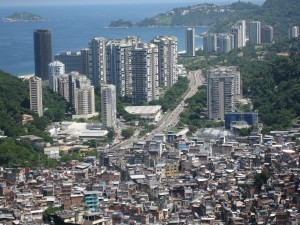“There are two cities within one..(one) part has all the benefits of urban living, and the other part, the slums and squatter settlements, where the poor often live under worse conditions than their rural relatives.” Anna Tibaijuka
The United Nations defines slums as poor, overcrowded communities lacking adequate access to basic necessities like drinking water and sanitation, public services, basic infrastructure and quality housing. Slums exist outside the official city grid, built without any proper planning and are in a constant state expansion and transformation.
In 2008, for the first time in history more people lived in cities than in rural areas. One third of these urban dwellers live in slums. The United Nations forecasts that the number of slum dwellers will double within the next 25 years. Urban slums are the world’s fastest growing human habitat.
All cities have their slums and their informal settlements. The size, proportion and character of these slums vary not merely with income but also with the social, political and legislative environment. Slums develop during high urbanization which causes the influx of labor from the countryside to the city to go far beyond the housing and absorption capacity of the city. They are usually characterized by higher incidence of violence due to lack of attention from local authorities or the government, higher occurrence of epidemics due to poor sanitation and lack of healthcare facilities and higher incidences of child labor, prostitution and substance abuse.
Mega cities are a primary phenomenon of the developing world. The combination of high population density amid poverty and limited resources makes an environment which favors the rapid growth of slum areas. As India is still on the path to development, there is a large number of people living below the poverty line. Slums in India have attained an alarming proportion in the larger cities like Mumbai, Delhi and Kolkata. The National Commission on Urbanization estimated that in 1981 out of the total urban population of 160 million, 32 to 40 million people or 6 to 8 million household were living in slums. That was around 20 – 25% of the urban population. Since then, it has gone up to 30 to 50% in different large cities and metropolises. It was projected that by 2001, there would be 60 to 75 million people living in slums in India.
Despite the general opinion that slums are unpleasant with extremely poor living conditions, it has been sometimes observed that for the poor rural migrants, life is actually better. Literacy rates have increased. access to health care has improved and life expectancy has increased. Slums are increasingly being viewed as integral places to a city as the slum population provides cheap work force, which actually helps develop and improve the city’s economy. Urban planning initiatives consider ways of upgrading and improving the slums rather than trying to get rid of them completely as this population will play a considerable part in the growth and future of the city. Thus, in a way slums are not only inevitable, they measure the success of a city. The formation of slums is an integral part in the growth and development of a city. In fact, a city with no slums will not have a strong work force to help it grow and hence its development may remain stagnant.
Mumbai is one of India’s megacities. It has an estimated population of 14 million, of which nearly 6 million live in slums. Dharavi is Mumbai’s biggest and most famous slum. It has is one of the highest population densities in the world. Despite its “slum” status, Dharavi is actually a thriving work – cum – residential settlement which specializes in leather manufacturing. In fact, Dharavi is one of the largest leather manufacturing units in the world. Hence, despite its high population density and lack of infrastructure Dharavi is a unique and thriving industrial complex.
Slums represent a survival strategy in the face of insufficient and affordable housing and lack of security. Despite all inherent problems, slum provide some basic lessons :
- The houses in slums are some of the smallest possible. Most of the spaces in these shelters are used as multi – functional spaces, with common spaces of living and family interaction. Thus, these dwellings are probably the best examples of optimum utilization of living space.
- Slum dwellings are people’s own solutions for their housing needs. They are the cheapest and most affordable possible in a given area.
- Slums are vibrant communities of people. They have integrated a whole range of social and community spaces.
- Slum- dwellers use minimum building materials to create their houses. They use easily available local building materials.
While slums may be born organically, they will not disappear automatically just because cities build more houses. The cities need to recognize that they urban poor are active agents and can contribute to economic growth. The slum is an inevitable part of modern urbanization, and our choice is to decide our vision for the slum of the future, the role of the slum, its design and purpose and how we can transform these slums to make them assets rather than liabilities. Countries need to recognize that the urban poor are active agents and can contribute to national growth.
Therefore, I believe a permanent and long term solution to the problem of slums cannot be about the slums themselves. It lies in focusing not only on building houses for the slum dwellers but also promoting livelihood options and social and economic infrastructure to develop the livelihood.
The services, social and economic livelihood of the slum people need to be acknowledged and included in designing solutions. This will make them more responsible towards their city and its infrastructure. We should study from their informal settlement about standards, layout and developmental pattern and create informal settlements and facilitate their growth and development.
Image Reference:
Image 1 - http://en.wikipedia.org/wiki/Slum
Image 2 - http://www.lifescienceworld.in/article_on_environment.html


